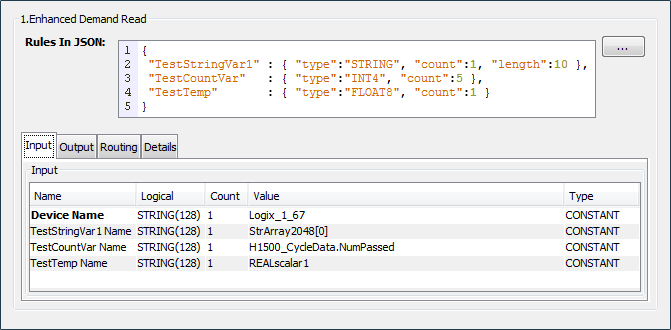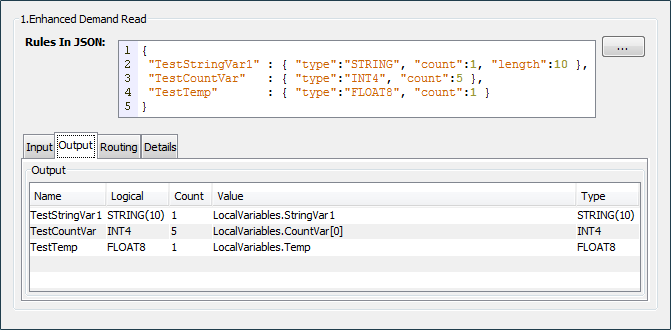The Enhanced Demand Read action reads a group of device variables at that point in a trigger's execution, bypassing the initial trigger buffer read at the start of the trigger's execution. When a trigger starts it execution, all variables referenced by the trigger's actions are read into internal buffers. The variables values are read from or written to this internal buffer when the variables are referenced by any of the trigger's actions. The internal buffer is written to the devices when the trigger completes its execution.
To bypass this internal buffering, the Enhanced
Demand Read action forces a read of the device
variables through the device manager and device driver to
the device.
Example
{
"TestStringVar1": {"type":"STRING", "count":1, "length": 10},
"TestCountVar": {"type":"INT4", "count":5},
"TestTemp": {"type":"FLOAT8", "count":1}
}The Enhanced Demand Read action is part of the Advanced Features package. For more information on obtaining and installing the package, see Packages.
Parameter descriptions
| Parameter | Description |
|---|---|
| Rules in JSON | The description of the device
variables to read. Each variable is
specified as shown in the example
with:
|
Input tab
The Input tab has the device name parameter and an input map variable for each variable identified in the JSON variable description.
| Parameter | Description |
|---|---|
| Device Name | The name of the device containing the variables whose values you want to read. |
| Input map variables |
The map variables identified in the
JSON variable description. Each variable in the JSON variable description will be added as a map variable row in the Input tab. In the Value column, specify the device variable name. The name can be a constant (entered directly in the parameter), or the name can be dynamically specified in a variable. In the example input tab above, the variables names are specified as constants. |
Output tab
The Output tab has an output variable
for each variable identified in the JSON variable
description.
Example
{
"TestStringVar1": {"type":"STRING", "count":1, "length": 10},
"TestCountVar": {"type":"INT4", "count":5},
"TestTemp": {"type":"FLOAT8", "count":1}
}| Parameter | Description |
|---|---|
| Output variables | Each variable in the JSON variable
description will be added as a row in
the Output tab. In the Value column, specify the variable where the value of the read input variable will be placed. The output variables can be trigger variables (local or static) or device variables. In the example output tab above, the variables are read into trigger local variables. |
Enhanced Demand Read considerations
Device variables are normally "read" when they are the source variable in an action. For example, a Set action has a source variable and a destination variable.
When a trigger starts it execution, all variables referenced by the trigger's actions are read into internal buffers. The variables' values are read from or written to this internal buffer when the variables are referenced by any of the trigger's actions. The internal buffer is written to the devices when the trigger completes its execution. This process maximizes performance of the trigger execution.
In cases where the device variables need to be read directly from the device at a certain point in the trigger's execution and not from the previously read internal trigger buffers, the Enhanced Demand Read action is used. These cases need to take into account the overall application logic in the triggers and in the devices to understand the dynamic interaction of all parts of the application. The Enhanced Demand Read action does take additional resources in terms of processing time (compared to for example a Set action), since the trigger engine and device driver must communicate down to the physical device and get a response. This includes the communication across the network to the device.
The data type specified for each variable must match the data type of the device variable. If it does not match, that variable will not be successfully read.
The action will fail if there is a problem with the device specified (not defined or not started). The action will succeed if there are individual problems with the variables specified. The variables that had individual problems (variable not defined, data type mismatch, data overflow writing to the output variable, data cast problem writing to the output variable) will not update the corresponding output variable. The variables that did not have a problem will update the corresponding output variables.
 can be used to display a larger
input area for the JSON variable
description.
can be used to display a larger
input area for the JSON variable
description.